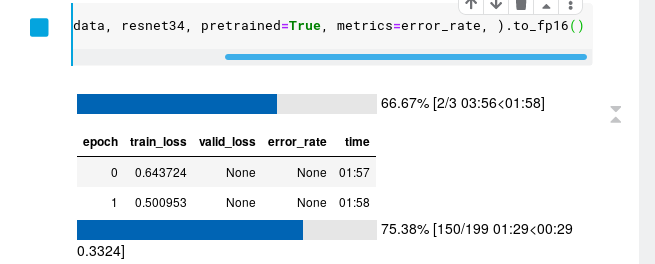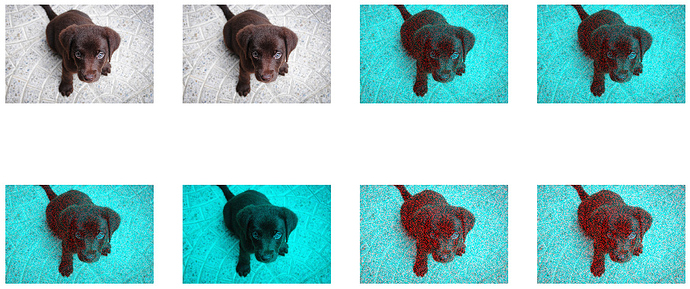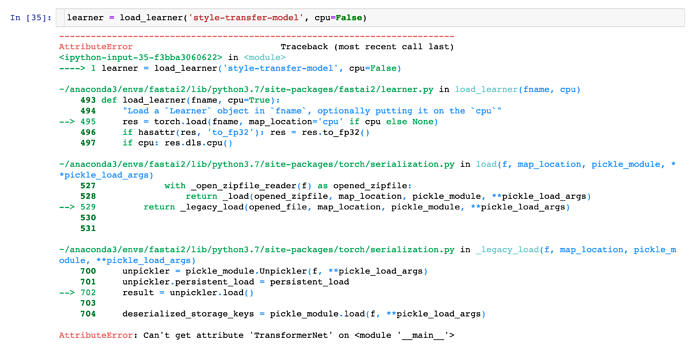Hi,
I am trying to implement rgb_transform on fastai2. Here is the code:
@patch
def rgb_randomize(x:TensorImage, channel:int=None, thresh:float=0.3, p=0.5):
"Randomize one of the channels of the input image"
if channel is None: channel = np.random.randint(0, x.shape[2])
x[:,:,channel] = 255*(torch.rand(x[:,:,channel].shape) * np.random.uniform(0, thresh))
return x
class rgb_transform(RandTransform):
def __init__(self, channel=None, thresh=0.3, p=0.5, **kwargs):
super().__init__(p=p)
self.channel,self.thresh,self.p = channel,thresh,p
def encodes(self, x:TensorImage): return x.rgb_randomize(channel=self.channel,thresh=self.thresh, p=self.p )
x = TensorImage(img)
_,axs = subplots(2, 4)
for ax in axs.flatten():
show_image(rgb_transform(channel=0, thresh=0.99)(x, split_idx=0), ctx=ax)
As you can see, the transform works nicely after modifying a little bit the code from v1. However, I am struggling now to applying in a project. If I do:
item_tfms=[RandomResizedCrop(size, min_scale=0.35)]
batch_tfms=[*aug_transforms(flip_vert=True, xtra_tfms=rgb_transform(channel=1, thresh=0.99, p=0.9))]
dblock = DataBlock(blocks=(ImageBlock, CategoryBlock),
splitter=GrandparentSplitter(),
get_items=get_image_files,
get_y=parent_label,
item_tfms = item_tfms,
batch_tfms=batch_tfms)
dbunch = dblock.dataloaders(path, path=path, bs=bs, num_workers=8)
dbunch.show_batch()
I got images without any rgb_transform. However, if I do:
dblock.summary(path)
I see that the transform is applied:
Setting-up type transforms pipelines
Collecting items from /home/jg/DeepLearning/Datasets/Colon_9_classes/images
Found 107180 items
2 datasets of sizes 100000,7180
Setting up Pipeline: PILBase.create
Setting up Pipeline: parent_label -> Categorize
Building one sample
Pipeline: PILBase.create
starting from
/home/jg/DeepLearning/Datasets/Colon_9_classes/images/train/Background/BACK-WQRMCART.tif
applying PILBase.create gives
PILImage mode=RGB size=224x224
Pipeline: parent_label -> Categorize
starting from
/home/jg/DeepLearning/Datasets/Colon_9_classes/images/train/Background/BACK-WQRMCART.tif
applying parent_label gives
Background
applying Categorize gives
TensorCategory(1)
Final sample: (PILImage mode=RGB size=224x224, TensorCategory(1))
Setting up after_item: Pipeline: RandomResizedCrop -> FlipItem -> ToTensor
Setting up before_batch: Pipeline:
Setting up after_batch: Pipeline: rgb_transform -> IntToFloatTensor -> AffineCoordTfm -> LightingTfm
Building one batch
Applying item_tfms to the first sample:
Pipeline: RandomResizedCrop -> FlipItem -> ToTensor
starting from
(PILImage mode=RGB size=224x224, TensorCategory(1))
applying RandomResizedCrop gives
(PILImage mode=RGB size=224x224, TensorCategory(1))
applying FlipItem gives
(PILImage mode=RGB size=224x224, TensorCategory(1))
applying ToTensor gives
(TensorImage of size 3x224x224, TensorCategory(1))
Adding the next 3 samples
No before_batch transform to apply
Collating items in a batch
Applying batch_tfms to the batch built
Pipeline: rgb_transform -> IntToFloatTensor -> AffineCoordTfm -> LightingTfm
starting from
(TensorImage of size 4x3x224x224, TensorCategory([1, 1, 1, 1], device='cuda:0'))
applying rgb_transform gives
(TensorImage of size 4x3x224x224, TensorCategory([1, 1, 1, 1], device='cuda:0'))
applying IntToFloatTensor gives
(TensorImage of size 4x3x224x224, TensorCategory([1, 1, 1, 1], device='cuda:0'))
applying AffineCoordTfm gives
(TensorImage of size 4x3x224x224, TensorCategory([1, 1, 1, 1], device='cuda:0'))
applying LightingTfm gives
(TensorImage of size 4x3x224x224, TensorCategory([1, 1, 1, 1], device='cuda:0'))
Any idea why is not working?
Thanks
 and want to revisit, but for now i am ok with understanding that if c is not set correctly, we’ll get a tensor size error. thanks for answering my question.
and want to revisit, but for now i am ok with understanding that if c is not set correctly, we’ll get a tensor size error. thanks for answering my question.



